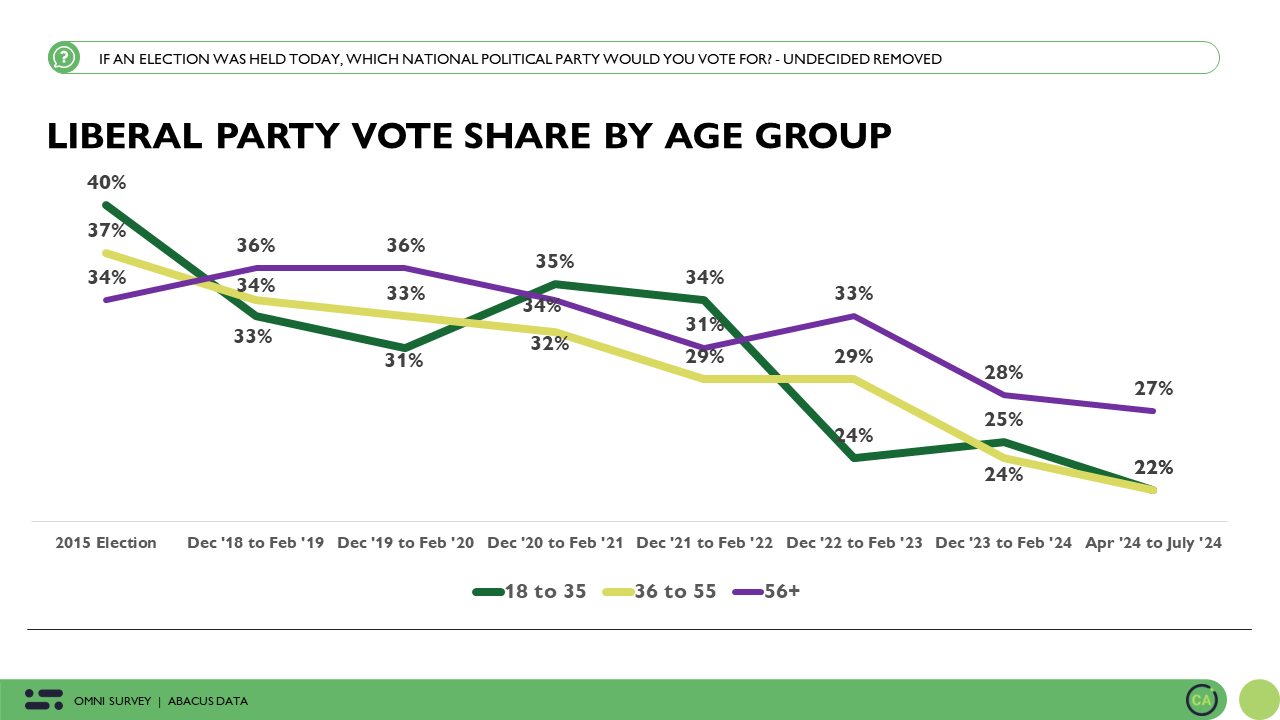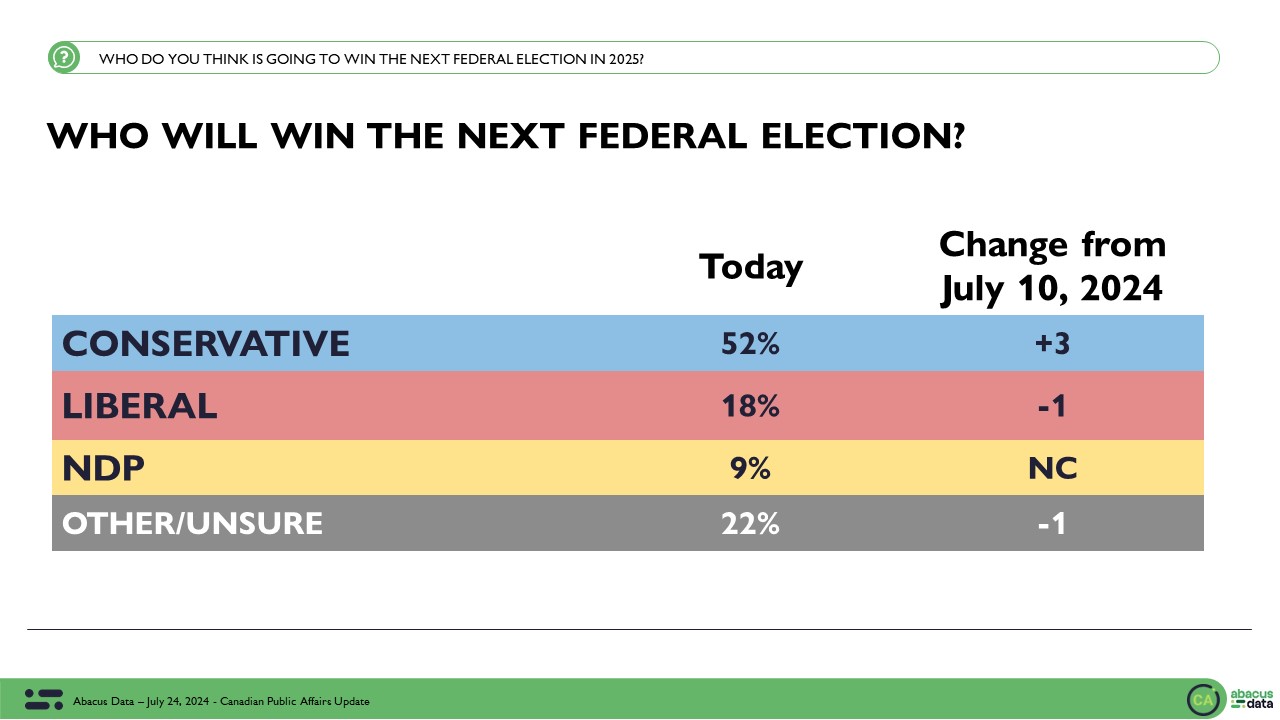Tight race between Conservatives and Liberals continues as voter fluidity remains high
July 6, 2019
This week we completed a large national survey of over 3,000 Canadian adults. Along with our usual update on the political landscape, we also explore the issues Canadians say will affect how they vote.
THE WORLD AND AMERICA ARE HEADING IN THE WRONG DIRECTION
For every Canadian (17%) who thinks the world is heading in the right direction, almost four (62%) feel that it is off on the wrong track. Almost identical numbers feel the same way about the US: 18% say it is heading in the right direction, 70% say America is off on the wrong track.
This is something that majorities of supporters of all parties see, is the majority view in all regions and across all generations.
WHAT ABOUT CANADA?
Canadians are quite a bit more likely to say things are heading in the right direction here (35%) compared to the US or the world in general, but the plurality of Canadians continue to feel the country is headed off on the wrong track (43%).
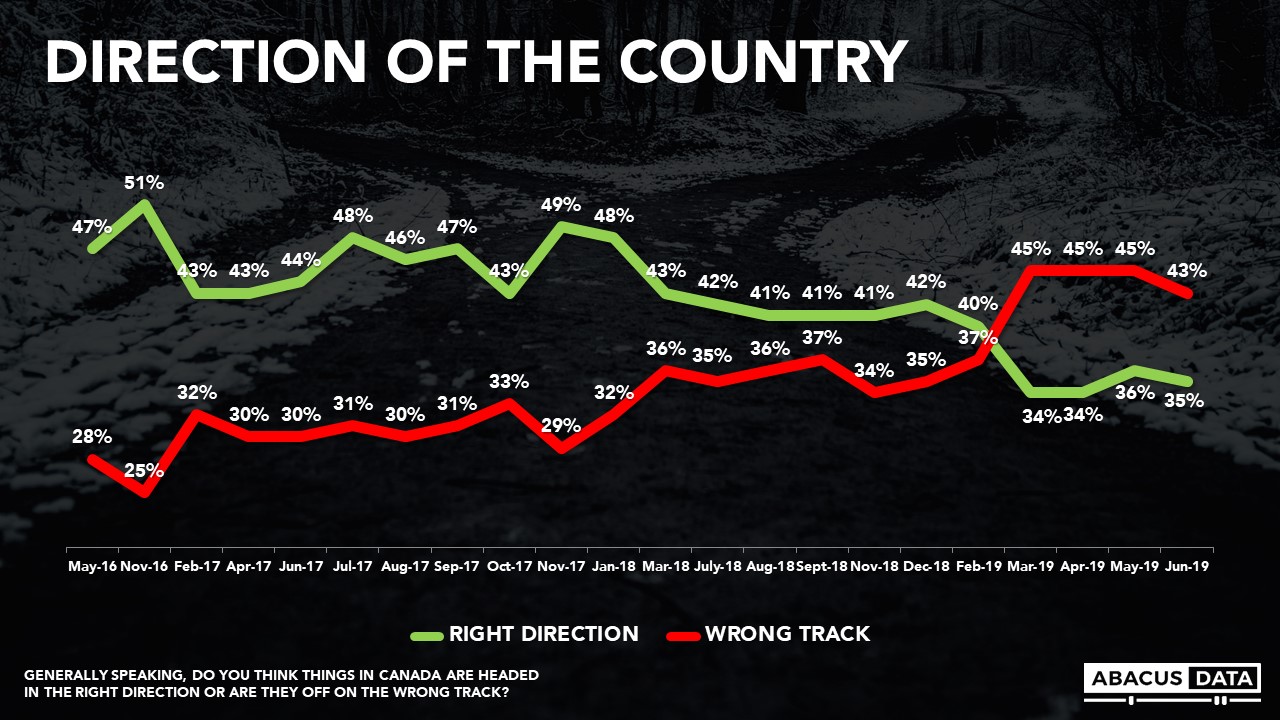
The mood of the country has remained static over the past few months. Liberal Party supporters (68%) feel Canada is headed in the right direction, while Conservative supporters are the least likely to feel this way (17%). NDP and Green Party supporters have mixed opinions with about three in ten feeling things are headed in the direction and about four in ten feeling they are off on the wrong track.
While positive feelings about the direction of the United States and the world have remained static since we started tracking them, views on Canada have dropped.
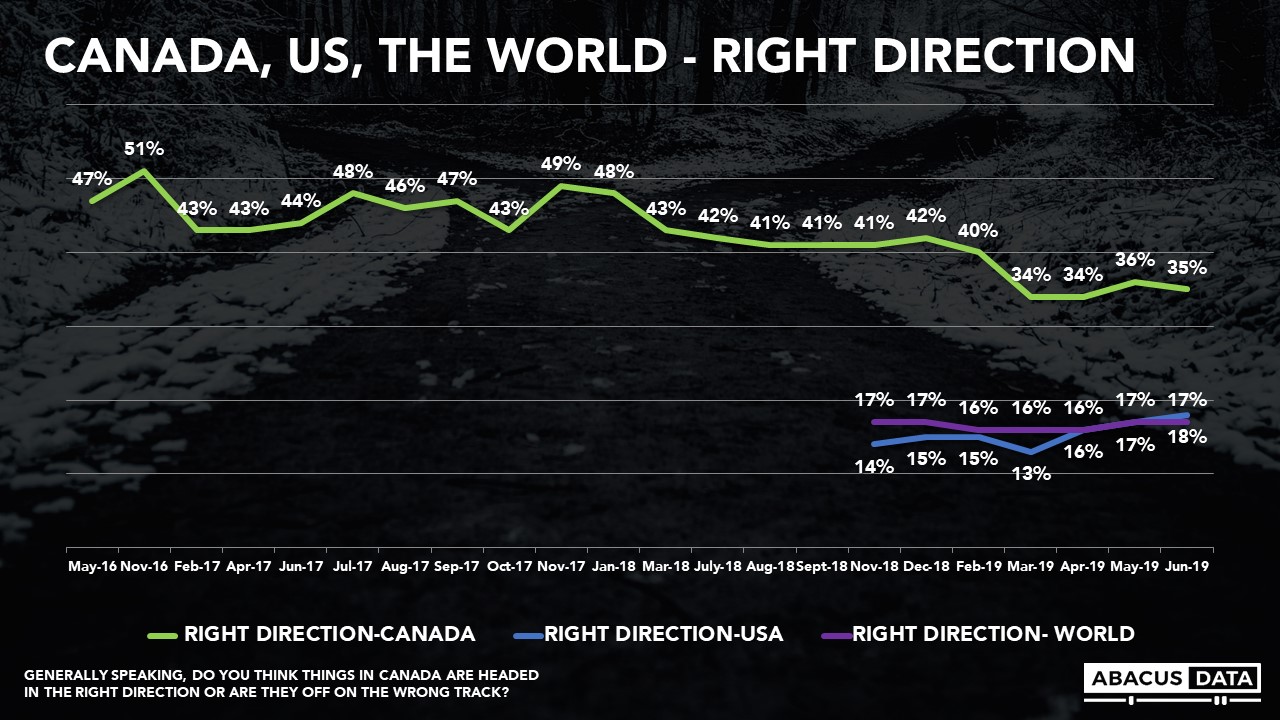
SLIGHT IMPROVEMENT IN ASSESSMENTS OF THE FEDERAL GOVERNMENT
Today 35% approve of the performance of the Trudeau government, while 47% disapprove. In April approval stood at 32%.
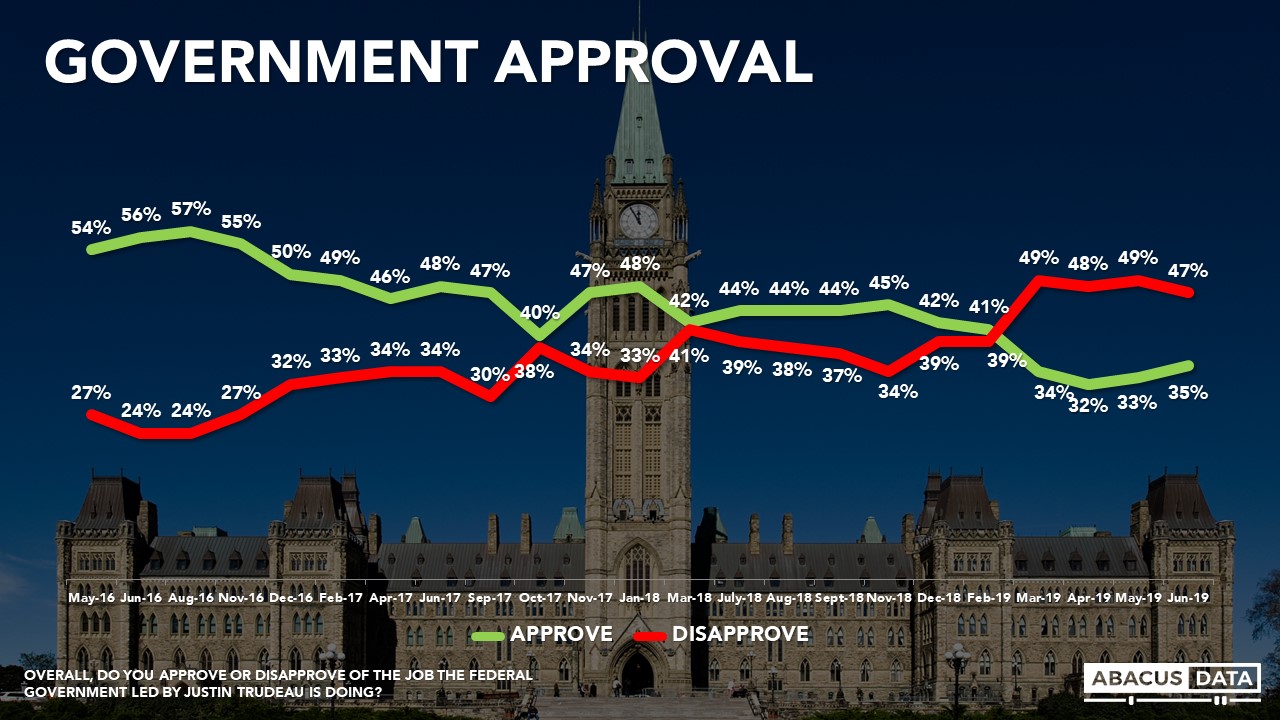
ACCESSIBLE VOTER POOLS REMAIN PRETTY STABLE
Accessible voter pools for the Liberals (49%), Conservatives (47%) and NDP (44%) are largely unchanged from our May survey. The Green Party pool remains high at 41% but 3 points lower than in May. In Quebec, 31% would consider voting for the BQ, up three since May.

Some other findings of note:
• 20% of 2015 Liberal voters say they would not consider voting Liberal today. Most have shifted towards the Conservatives (56%), while 30% would vote NDP (15%) or Green (15%).
• Only 5% of past Conservative Party voters say they would no longer consider voting for the Conservatives.
• For the NDP, 15% of 2015 NDP voters remain open to voting for the party this year, almost half of whom live in Quebec. The biggest challenge for the NDP remains conversion of “willing to consider” to “would vote for them today”: just 29% of those who would consider the NDP would cast a ballot for the NDP today. As many (28%) would vote Liberal, 15% would vote Conservative, and 10% Green.
IF THE ELECTION WERE TOMORROW? A TOSS UP.
If an election were held tomorrow, 33% say they would vote Conservative, 32% Liberal, 16% NDP, and 11% Green. These numbers are very similar to those in our last poll.

Below the national numbers, we are seeing a softening of Liberal support in Quebec as the Conservatives pick up some support. Ontario remains deadlocked, while BC remains a close three-way race with the Liberals slightly ahead of the Conservatives. We have the Liberals ahead by 10 in Atlantic Canada.

CONSERVATIVES WOULD WIN IF ONLY OLDER PEOPLE VOTED.
Generation gaps persist: the Conservatives would win an election if the only voters were 45 older, while the Liberals would prevail if the only voters were under 45. Green Party support is twice as high among those under 30 as it is among those 60 or older.

AMONG UNION MEMBERS, THE LIBERALS LEAD & THE NDP IS THIRD.
Union members are important buttresses for the Liberal Party today. Members of private sector unions are twice as likely to vote Liberal rather than NDP, and public sector union members lean similarly towards the Liberals over the NDP. The Conservatives trail the Liberals among all union members and lead the Liberals by 3 among non-union voters.
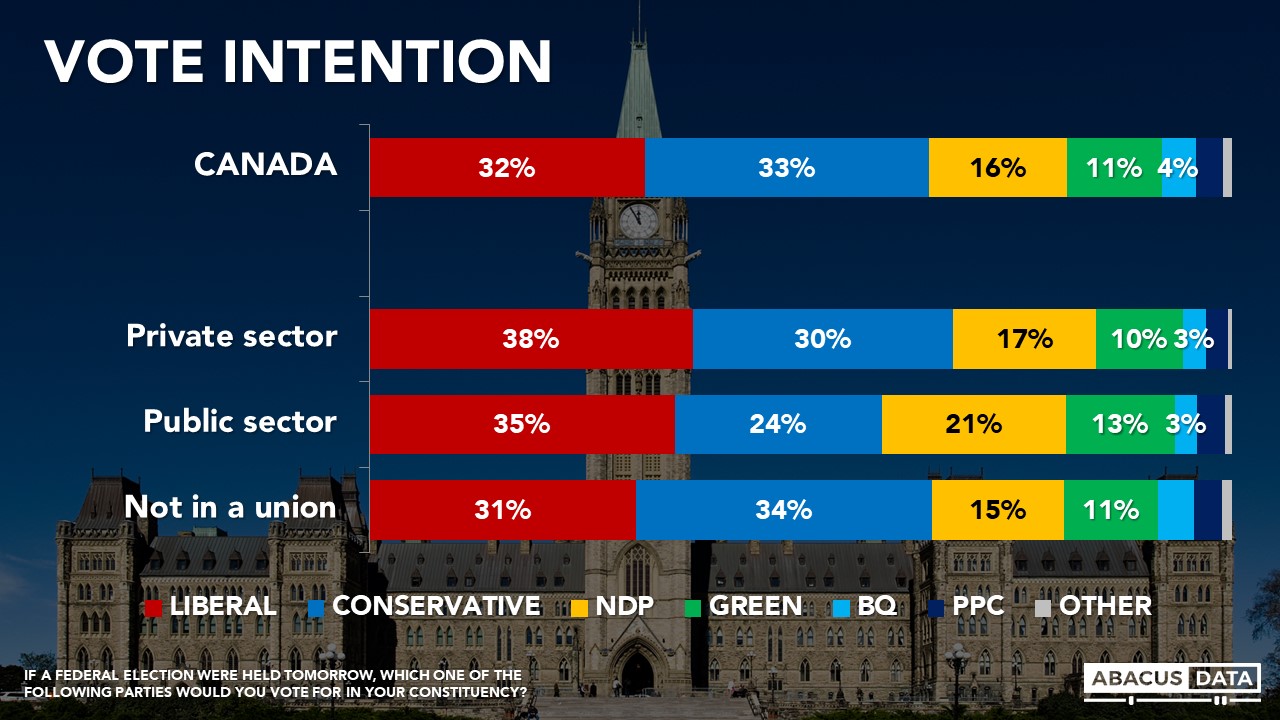
GENDER GAP? CONSERVATIVES AND LIBERALS TIED AMONG MEN AND WOMEN
Conservatives lead by 2 over the Liberals (34% to 32%) with the NDP at 13% and Greens at 9%. Among women, the Liberals are ahead by 1 over the Conservatives (32% to 31%) with the NDP at 18% and the Greens at 13%.
HIGH SCHOOL EDUCATED VOTERS PREFER THE CONSERVATIVES
Conservatives have a strong lead among those who have not attended college or university, while the Liberals have a lead among those with university education, and a wide lead among those with more than one degree.
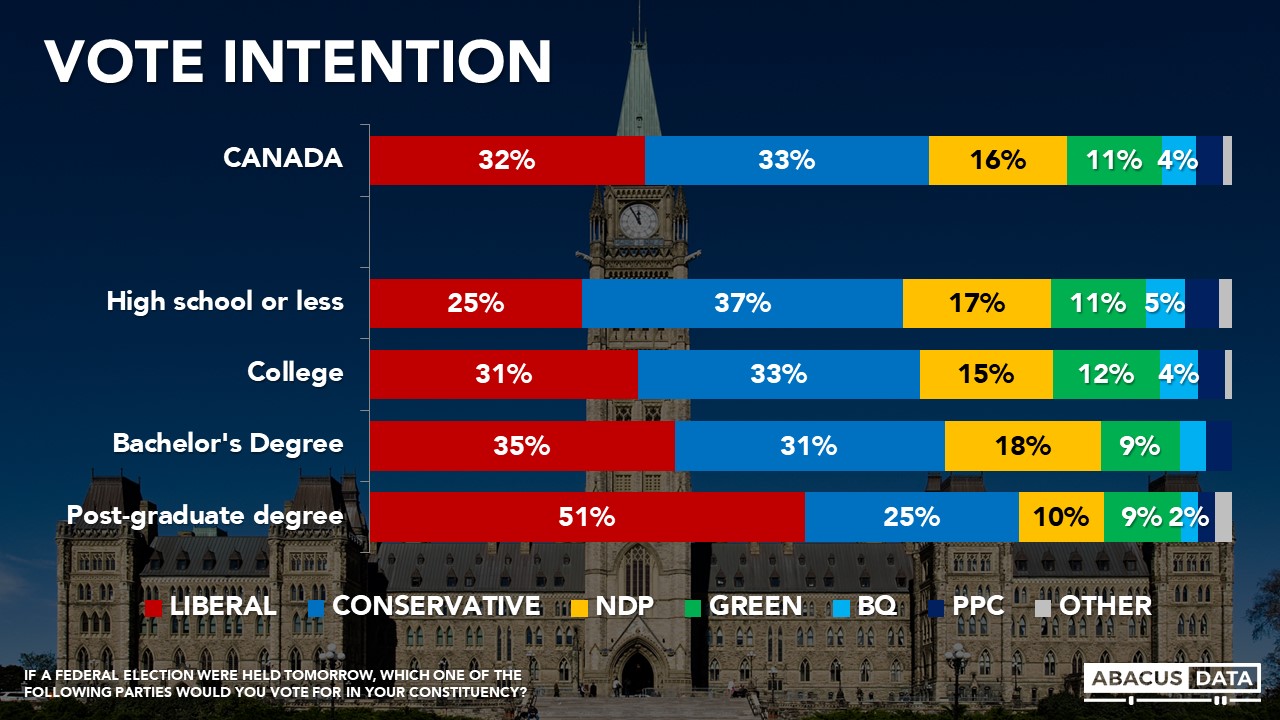
PREFERRED PRIME MINISTER
Asked which party leader they would prefer to see as Prime Minister after the election, 35% picked Justin Trudeau (up 2 since May), 31% Andrew Scheer (up 1), 14% Elizabeth May (down 5), 13% Jagmeet Singh (up 1), and 7% Max Bernier (up 1).
Among Liberal supporters, 89% would prefer Justin Trudeau to be Prime Minister. Among Conservative supporters, 88% would prefer Andrew Scheer, but among NDP supporters, only 2 in 3 would prefer Jagmeet Singh to be Prime Minister after the election. The same is true of Elizabeth May. Only 68% of those who would vote Green want her to be PM after the next election.

REPUTATION OF LEADERS: TRUDEAU NUMBERS TICK UPWARDS A BIT
Today, 35% say they have a positive view of Mr. Trudeau and 46% negative, a slight improvement since May. For Mr. Scheer, 34% viewing him negatively compared with 31% positively. This is largely unchanged since May.


For Mr. Singh, we see 26% positive and 25% negative, a slight improvement in his numbers overall. For Ms. May, we find 32% positive, 17% negative, a 5-point climb in positive ratings since April.
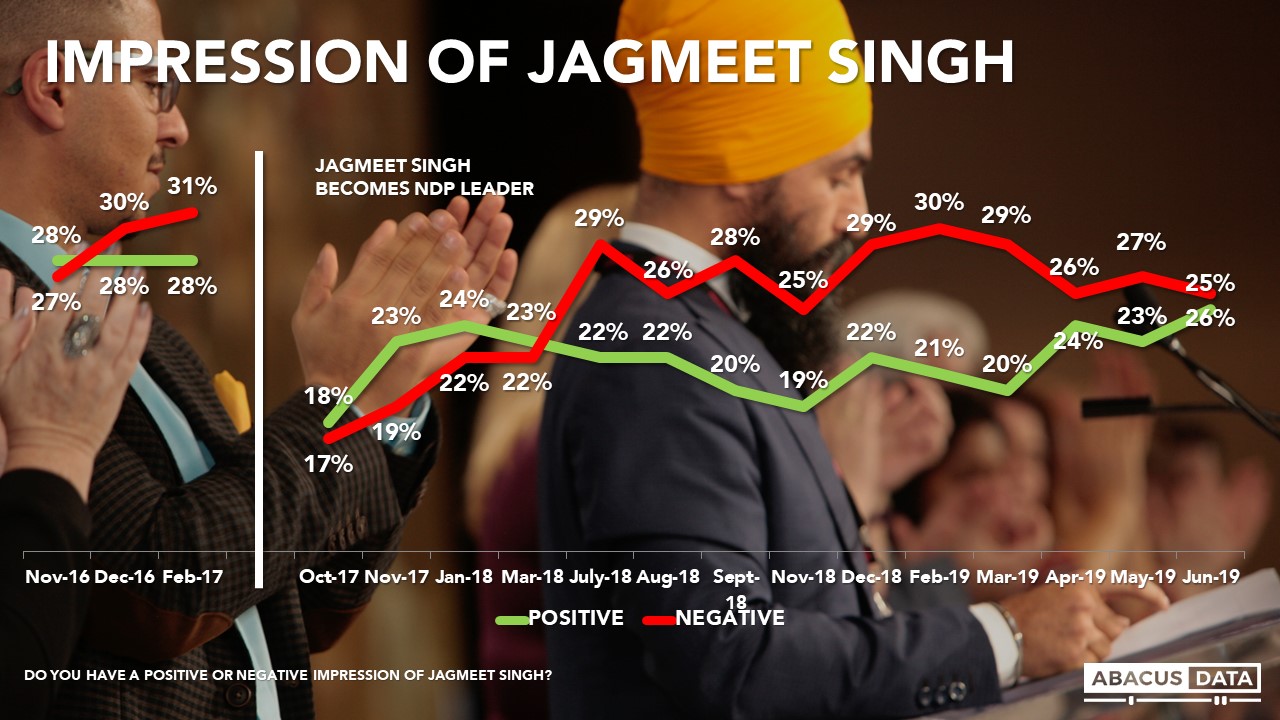

DOUG FORD REMAINS DEEPLY UNPOPULAR
Worth noting is the fact that Doug Ford continues to show remarkably high negative ratings nationally (55%) and in Ontario (62%). The recent cabinet shuffle and departure of his chief of staff has not – to this point anyway – reversed the negative trend. Today, only 20% of Ontarians have a positive impression of Premier Ford, down 2 since May.
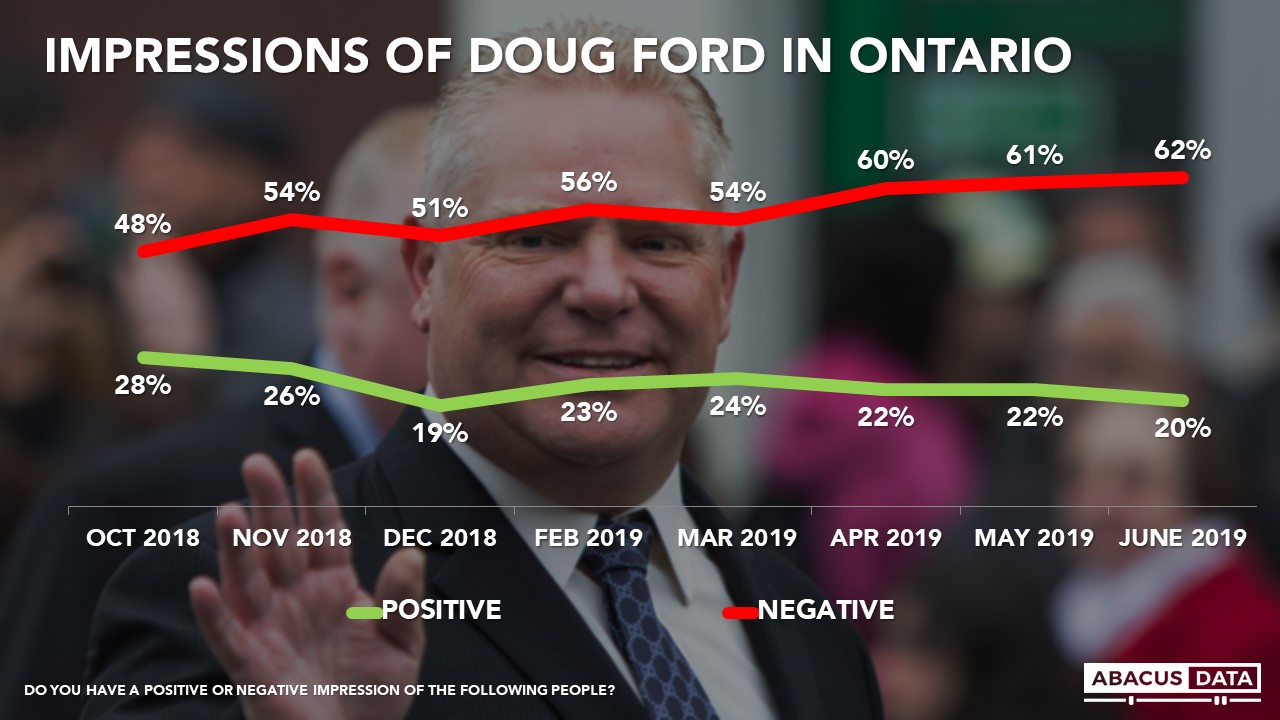
VOTER FLUIDITY & SECOND CHOICES
We continue to see a high degree of potential volatility. Four in ten Liberal and NDP voters say they are likely or very likely to be persuaded to vote for a party other than the one they currently support, and 53% of Green supporters say the same thing. One in three Conservative supporters says they may be persuaded to switch their vote.

Among Liberal voters who could defect, the NDP would pick up 42% followed by the Greens (22%) and the Conservatives (21%). Among NDP potential defectors, 39% see the Liberals as their second choice while 34% would vote Green and 16% Conservative. Among Green Party supporters who might switch, the NDP 38% and the Liberals 27% would pick up most of that support, followed by the Conservatives at 11%.
For the Conservatives, 27% say they would vote NDP if not Conservative, 21% Liberal, and 18% Green.
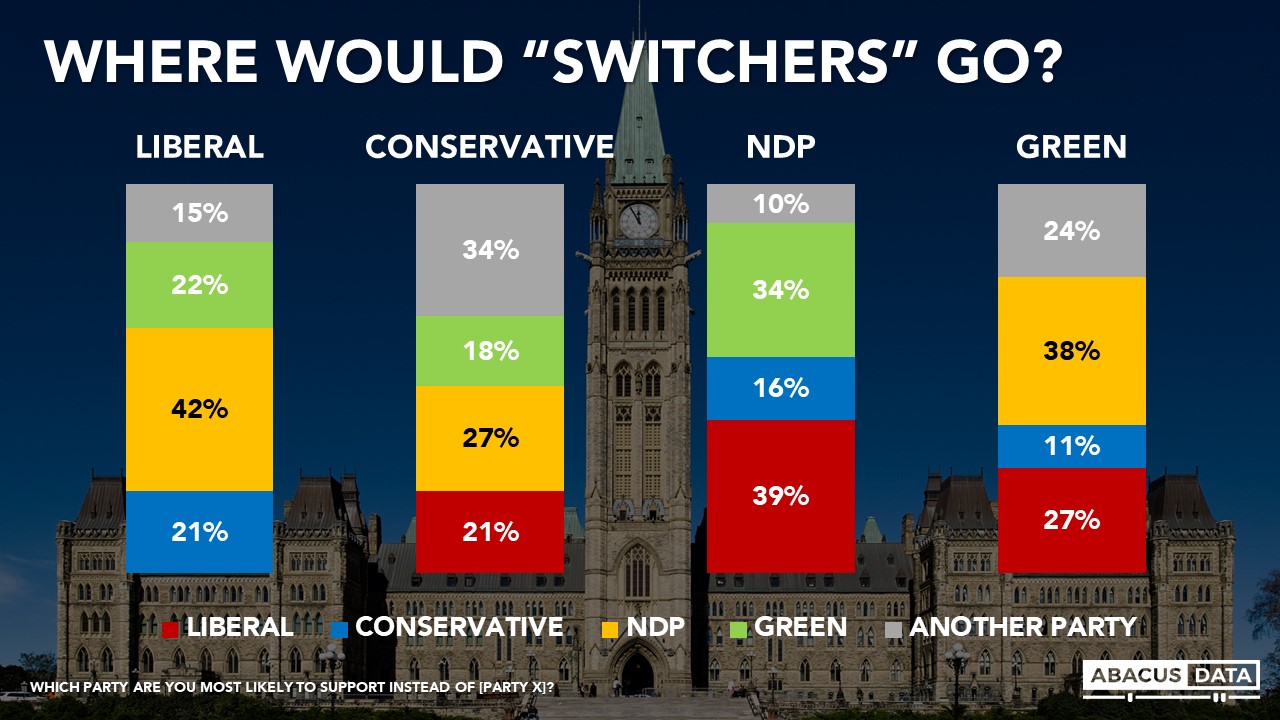
What these numbers highlight is two things. First, a strong NDP campaign could thwart Liberal hopes, and the opposite is true too: a weak outing for the NDP will create growth opportunities for the Liberals. Second, the Conservatives have the best potential to hold their current vote, but a relatively weak prospect of picking up switchers from other parties.
UPSHOT
According to Bruce Anderson: “The late winter saw a lot of downward pressure for the Liberals around the Wilson-Raybould, SNC issue, and growing opportunity for the Conservatives. The impact of that issue may be dissipating now, which is helpful for the Liberals, as is the ongoing public opinion about Ontario Premier Doug Ford.
The Conservative path to victory at this point rests on climate concerned and progressive voters splitting their votes three ways plus avoiding a situation where the prospect of a Scheer government becomes tied to the austerity and other image problems besetting the Ford Conservatives in Ontario. Their prospects improve if they can also become more appealing as a second choice and make a stronger connection with younger and more highly educated voters.”
According to David Coletto: “With just over three months to go before election day, I continue to see a highly competitive and fluid political environment. The mood of Canadians remains defensive, while slightly improving, the Prime Minister’s image remains negative, but there’s little affection for any of his opponents save for Ms. May.
Our data does offer some clues about where the election might go, and next week I’ll share some potential scenarios based on some analysis I’ve been doing. But in the meantime, it’s clear that the Liberals will continue to tell what they see as a positive story about their time in government – low unemployment, expanded trade, and reducing inequality. It needs to convince more of its former supporters that the country is indeed headed in the right direction and now is not the time to revert course to the Conservatives.
For the Conservatives, there’s still a clear path to victory for them, but they have made little progress in expanding their support, despite the vulnerability of the Liberals. They have been stuck in our tracking in the low 30s for most of the past few years. Either they will rely on lower turnout and a more motivated base to get them over the line or expand the audience and convert past Liberal and NDP supporters to their view of the world.
The NDP continues to struggle to gain any traction. While their vote intention numbers and accessible voter pool remain constant, their leader remains unknown, their base in Quebec has completely disintegrated, and they have no clear policy advantage yet. Even with the release of their full platform, we see no bounce or positive movement in any of their metrics.
Finally, while the Greens remain in a much better position than they did only a few months ago, it appears that their momentum may have stalled or peaked. Their accessible voter pool has shrunk slightly over the past month and they haven’t been successful in converting more of it into actual supporters. The potential for a Green breakthrough remains in place but time is running out for the Greens.”
METHODOLOGY
Our survey was conducted online with 3,092 Canadians aged 18 and over from June 28 to July 2, 2019. A random sample of panellists was invited to complete the survey from a set of partner panels based on the Lucid exchange platform. These partners are double opt-in survey panels, blended to manage out potential skews in the data from a single source.
The margin of error for a comparable probability-based random sample of the same size is +/- 1.8%, 19 times out of 20. The data were weighted according to census data to ensure that the sample matched Canada’s population according to age, gender, educational attainment, and region. Totals may not add up to 100 due to rounding.
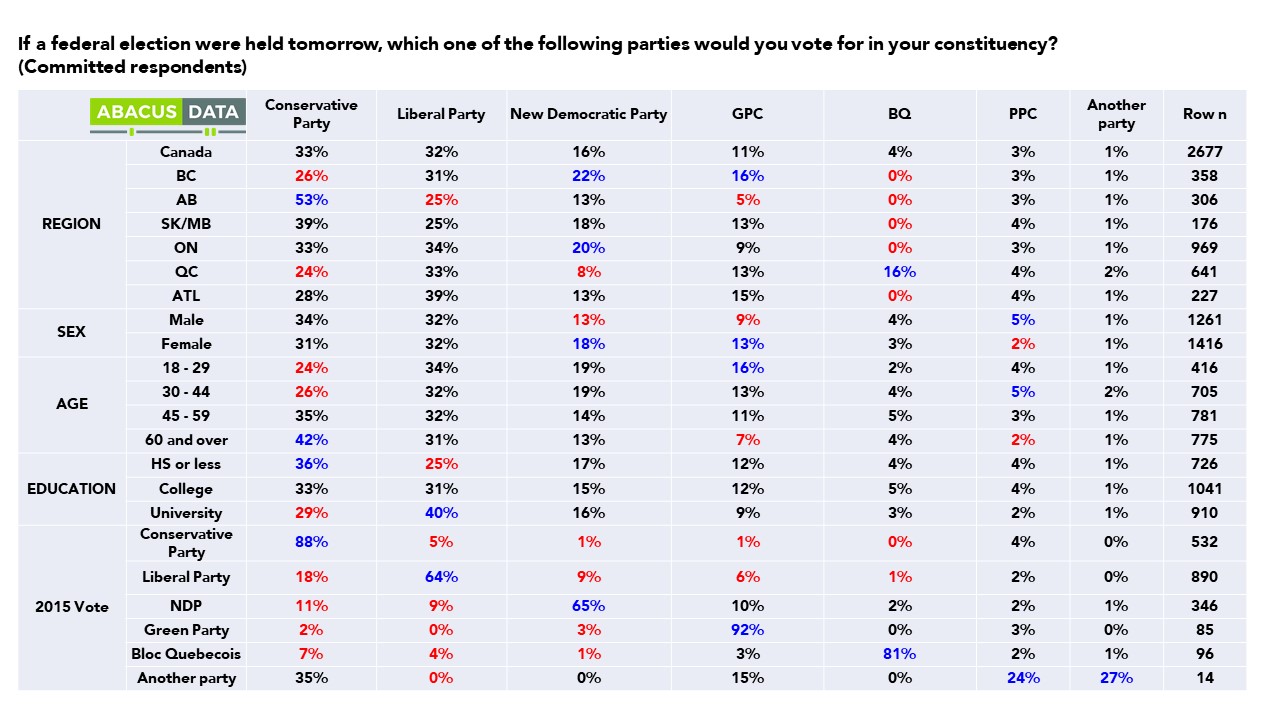
ABOUT ABACUS DATA
We are the only research and strategy firm that helps organizations respond to the disruptive risks and opportunities in a world where demographics and technology are changing more quickly than ever.
We are an innovative, fast-growing public opinion and marketing research consultancy. We use the latest technology, sound science, and deep experience to generate top-flight research-based advice to our clients. We offer global research capacity with a strong focus on customer service, attention to detail and exceptional value.
Contact us with any questions.
Find out more about how we can help your organization by downloading our corporate profile and service offering.



